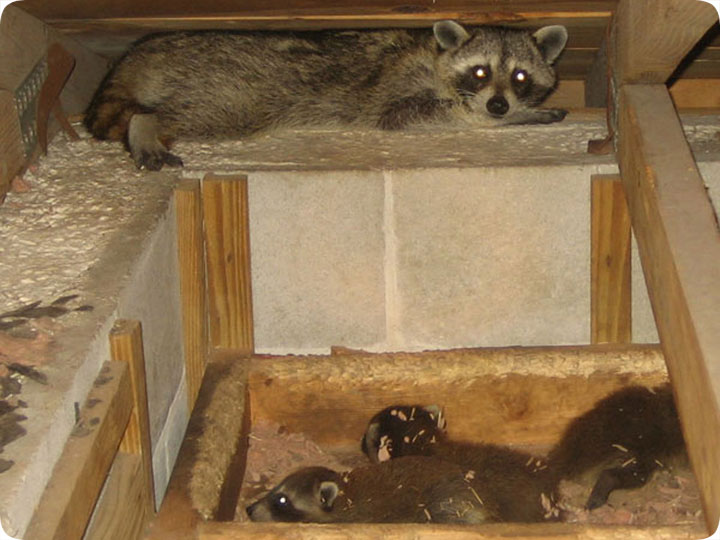-
info@aaanimalcontrol.com
Call us for help in your town
Humane Wildlife Education
Racoons in Attic

I arrive at the house and inspect the outside, and I can tell from the type of opening when it's a racoon. The opening is usually large, with some form of destruction, and muddy footprints - an easy tell. I sometimes set a special trap right at the opening if possible, and I enter the attic with a pillowcase and a snare pole and cage. I creep through the attic with my headlamp and dust mask on, and I search for the raccoons. I say raccoons, because 90% of the time, a raccoon in the attic is a female with a litter of young raccoons. Sometimes the baby coons are well-hidden, down a wall or eave somewhere, and sometimes they are easily spotted. Sometimes the mother raccoon flees at my presence, sometimes she sticks around to defend the young. If she flees, she might run into the trap I've set. If she sticks around, I have a chance to snare her with my snare pole.
If I do snare the mother, I drag her to the cage I've brought, and take her out of the attic. Then I go get the young and put them in the pillowcase, and bring them out of the attic. I then reunite them all together in the same cage. However, it's rare that I snare the mom in the attic. Most of the time she runs and hides or is too hard to catch. But I do always get the young. ALWAYS GET THOSE BABY RACCOONS! If you don't, they will suffer and die of starvation in the attic, then rot and cause a big odor problem. Also, I use the baby raccoons as "bait" to trap the mother raccoon, so that I have them all.
This job was a little unique because it was in September. Most of the time, raccoons have their young in the spring. This is a much more common sight in March or April than in September. However, here in Florida, the females can have young at any time of the year.
This is one of my best photos that I've taken of both a mother and her young raccoons in an attic. You can see that she's cleared out the insulation, chewed on the edges of the wood, and ripped the paper off the walls. Minor damage compared to a lot of the attic damage I've seen raccoons cause.
Do it yourself: Visit my How To Get Rid of Raccoons page for tips and advice.
Get professional help: Visit my Nationwide Pro Directory of wildlife removal experts.
The raccoon (Procyon lotor), is a unique animal native to North America. It's not closely related to any other animals, with distant relatives such as bears and weasels. Coons are easy to recognize, with a black mask and ringed tail. Raccoons tend to weigh between 10-20 pounds as adults. They are mostly nocturnal, and are omnivores. Racoons average a lifespan of about 5 years in the wild, and have a litter of 3-6 young each spring. They are very strong, excellent climbers, very intelligent, and they are very skilled with their hands. Raccoons have learned to thrive in urban areas, and live in very high densities in cities, where they eat garbage and pet food. They commonly break into homes and attics, where they cause considerable damage, and they also destroy other property, and thus racoons are considered pest animals by many people. Raccoon control and removal, especially from inside homes, is best left to a professional.
For more wildlife stories, click my Wildlife Blog or click my below banner to hire a local trapper.





















